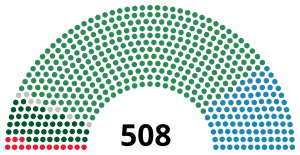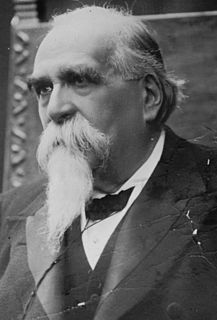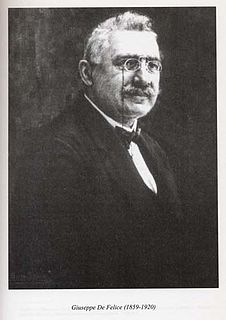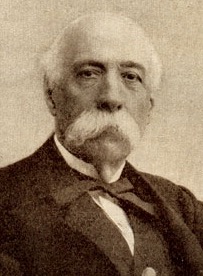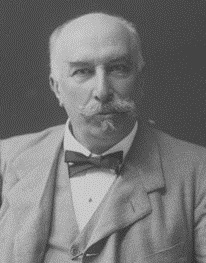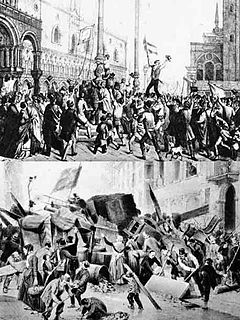Historical background
In December 1893 the impotence of the Giovanni Giolitti cabinet to restore public order, menaced by disturbances in Sicily and the Banca Romana scandal, gave rise to a general demand that Francesco Crispi should return to power. Although Giolitti tried to put a halt to the manifestations and protests of the Fasci Siciliani, his measures were relatively mild. In the three weeks of uncertainty before Crispi formed a government on December 15, 1893, the rapid spread of violence drove many local authorities to defy Giolitti’s ban on the use of firearms. In December 1893, 92 peasants lost their lives in clashes with the police and army. Government building were burned as well as flour mills and bakeries that refused to lower their prices when taxes were lowered or abolished. [3] [4]
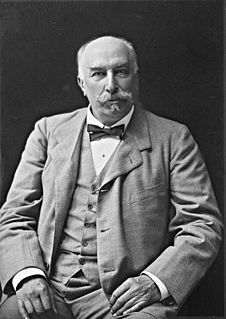
Giovanni Giolitti was an Italian statesman. He was the Prime Minister of Italy five times between 1892 and 1921. He is the second-longest serving Prime Minister in Italian history, after Benito Mussolini. He was a prominent leader of the Historical Left and the Liberal Union. Giolitti is widely considered one of the most powerful and important politicians in Italian history and, due to his dominant position in Italian politics, he was accused by critics of being a parliamentary dictator.
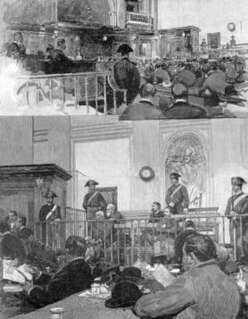
The Banca Romana scandal surfaced in January 1893 in Italy over the bankruptcy of the Banca Romana, one of the six national banks authorised at the time to issue currency. The scandal was the first of many Italian corruption scandals, and discredited both ministers and parliamentarians, in particular those of the Historical Left. The crisis prompted a new banking law, tarnished the prestige of the Prime Ministers Francesco Crispi and Giovanni Giolitti and prompted the collapse of the latter's government in November 1893.
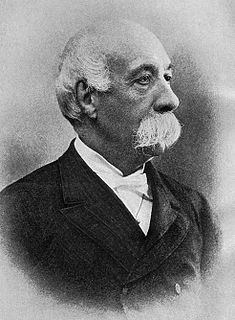
Francesco Crispi was an Italian patriot and statesman. He was among the main protagonists of the Italian Risorgimento and a close friend and supporter of Giuseppe Mazzini and Giuseppe Garibaldi, and one of the architects of the unification of Italy in 1860.
On January 3, 1894, Crispi declared a state of siege throughout Sicily. Army reservists were recalled and General Roberto Morra di Lavriano was dispatched with 40,000 troops. [5] [6] The old order was restored through the use of extreme force, including summary executions. A solidarity revolt of anarchists and republicans in the Lunigiana was crushed as well.

The Lunigiana revolt took place in January 1894, in the stone and marble quarries of Massa and Carrara in the Lunigiana, the northernmost tip of Tuscany (Italy), in support of the Fasci Siciliani uprising on Sicily. After a state of siege had been proclaimed by the Crispi government, armed bands dispersed into the mountains pursued by troops. Hundreds of insurgents were arrested and tried by military tribunals.
The repression of the Fasci turned into outright persecution. The government arrested not just the leaders of the movement, but masses of poor farmers, students, professionals, sympathizers of the Fasci, and even those simply suspected of having sympathized with the movement at some point in time, in many cases without any evidence for the accusations. After the declaration of the state of emergency, condemnations were issued for the paltriest of reasons. Many rioters were incarcerated for having shouted things such as "Viva l'anarchia" or "down with the King". At Palermo, in April and May 1894, the trials against the central committee of the Fasci took place and this was the final blow that signaled the death knell of the movement of the Fasci Siciliani. [7]

The Fasci Siciliani[ˈfaʃʃi sitʃiˈljani], short for Fasci Siciliani dei Lavoratori, were a popular movement of democratic and socialist inspiration, which arose in Sicily in the years between 1889 and 1894. The Fasci gained the support of the poorest and most exploited classes of the island by channeling their frustration and discontent into a coherent programme based on the establishment of new rights. Consisting of a jumble of traditionalist sentiment, religiosity, and socialist consciousness, the movement reached its apex in the summer of 1893, when new conditions were presented to the landowners and mine owners of Sicily concerning the renewal of sharecropping and rental contracts.
On June 16, 1894, the anarchist Paolo Lega tried to shoot Crispi but the attempt failed. [8] On June 24 an Italian anarchist killed French President Carnot. In this climate of increased the fear of anarchism, Crispi was able to introduce a series of anti-anarchist laws in July 1894, which were also used against socialists. Heavy penalties were announced for "incitement to class hatred" and police received extended powers of preventive arrest and deportation. [9]

Marie François Sadi Carnot was a French statesman, who served as the President of France from 1887 until his assassination in 1894.
Crispi steadily supported the energetic remedies adopted by his Minister of Finance Sidney Sonnino to save Italian credit, which had been severely shaken the financial crisis of 1892–1893 and the Banca Romana scandal. In 1894 he was threatened with expulsion from the Masonic Grande Oriente d'Italia for being too friendly towards the Catholic Church. [10] He had previously been strongly anticlerical but had become convinced of the need for rapprochement with the Papacy. [11]

Sidney Costantino, Baron Sonnino was an Italian statesman, 19th Prime Minister of Italy and twice served briefly as one, in 1906 and again from 1909 to 1910. He also was the Italian Minister of Foreign Affairs during the First World War, representing Italy at the 1919 Paris Peace Conference.
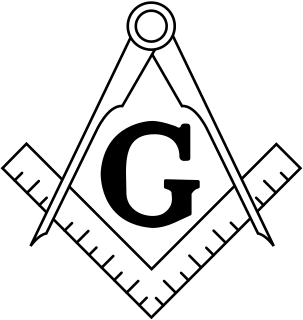
Freemasonry or Masonry consists of fraternal organisations that trace their origins to the local fraternities of stonemasons, which from the end of the fourteenth century regulated the qualifications of stonemasons and their interaction with authorities and clients. The degrees of Freemasonry retain the three grades of medieval craft guilds, those of Apprentice, Journeyman or fellow, and Master Mason. The candidate of these three degrees is progressively taught the meanings of the symbols of Freemasonry, and entrusted with grips, signs and words to signify to other members that he has been so initiated. The initiations are part allegorical morality play and part lecture. The three degrees are offered by Craft Freemasonry. Members of these organisations are known as Freemasons or Masons. There are additional degrees, which vary with locality and jurisdiction, and are usually administered by their own bodies.
Crispi’s uncompromising suppression of disorder, and his refusal to abandon either the Triple Alliance or the Eritrean colony, or to forsake his Minister of the Treasury, Sidney Sonnino, caused a breach with the radical leader Felice Cavallotti. Cavallotti began a pitiless campaign of defamation against him. The unsuccessful attempt upon Crispi’s life by the anarchist Lega brought a momentary truce, but Cavallotti’s attacks were soon renewed more fiercely than ever. They produced little effect and the general election of 1895 gave Crispi a huge majority. Nevertheless, the humiliating defeat of the Italian army at Adwa in March 1896 in Ethiopia during First Italo-Ethiopian War, brought about his resignation after riots broke out in several Italian towns. [12] [13]
This page is based on this
Wikipedia article Text is available under the
CC BY-SA 4.0 license; additional terms may apply.
Images, videos and audio are available under their respective licenses.












